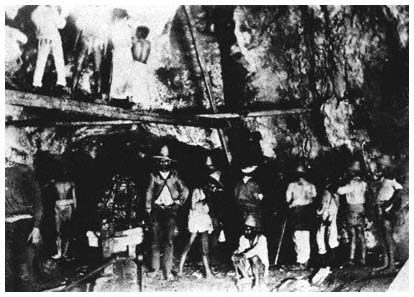The Baja Mining Circuit and Peninsular Families
While most mines on the mainland were worked by an ample local labor pool, Baja California first depended on imported labor. Around mid-century groups of Yaquis were brought across the gulf to work the new mines. Only later did peninsulars begin heading to the interior mines (see Aschmann 1967; Bernstein 1964; Martinez 1965; North 1908). The mines were supported by migrant populations that soon were making the labor circuit of the mines much like the great piscas (seasonal fruit-picking migrations) of Alta California in the twentieth century.
During this short period mining became a way of life for the individuals who moved up and down the Baja peninsula from mine to mine. The baja barretero (miner) viewed his existence as dependent on mining in the peninsula. The mines, mining towns, and their geography became a principal aspect of family lore.
Peninsular miners worked and traveled to various spots on the mainland as well (see chapter 5). During the late 1880s and particularly in the early twentieth century the copper mines of Cananea attracted numerous peninsular families. Many of these individuals worked in Santa Rosalía and learned valuable skills that they transferred to other jobs during their lives.
The peninsular miners and families of this study came primarily from the southern portion of the peninsula. The small rancho towns there were unable to support growing populations and the mines provided an outlet. In the late 1880s and early 1890s the mines of San Juan (in Las Flores on the Gulf Coast) and Calmallí in the central desert attracted individuals and families from the cape region and from the mainland west coast. Many families traveled to join relatives with hopes

Typical gold and silver mine in Mexico showing methods of interior mining,
barreteros (miners), peons, and the gang leader ( capataz ). September 1890.
(Bain Collection, Library of Congress)
of participating in the mining ventures. Later, in the late 1890s, families migrated into the northern peninsula mines of Punta Prieta, Julio César, El Marmol, and El Alamo.
The peninsular families, unlike the miners of the gold strikes of Alta California, became company miners. The large placers required shaft operations and smelter work in which semiskilled labor could be used. The majority of these migrants were not aiming to strike it rich but were seeking employment and a life-style similar to what they knew in their hometowns in the south. They became barreteros , miners who actually worked within the mines or shafts, and a few subsisted on the support economies of such as leñadores (wood collectors) and small store operators. These individuals formed the working class component of the mine operations, under the supervision of the company engineers and managers.
The social interaction between the English, American, and French company men and peninsulars was very different from that in previous
decades of foreign immigration. Where peninsulars had intermarried and interacted socially with the otter traders, whalers, and others during the early mid-century, the mines produced a labor-company stratification. Company managers and operators separated themselves socially from the common mine laborers and their families.
Although the mines of Baja California were quickly exhausted and abandoned by capitalists, these mines stimulated development of the border region in Alta California. Small economies in San Diego blossomed and expanded because of the mining boom in Baja. The port of San Diego bustled with steamers heading to the south loaded with passengers, materials, and foodstuffs. Furthermore, populations of San Diego and Southern California, having increased tremendously during the land boom of the late 1800s, became increasingly aware of available land on the peninsula. Developments along the U.S. side of the border began entering the adjacent border lands and were to bring land and population development of the frontera region as a whole. The Porfiriato foreign investment policies that had brought about the development of mining also stimulated the development of the frontera.